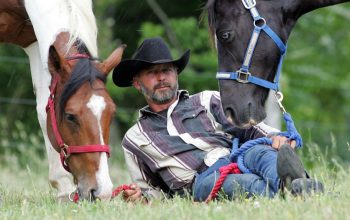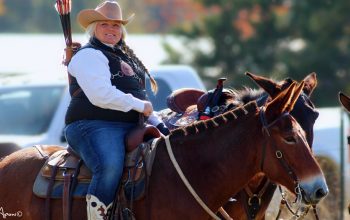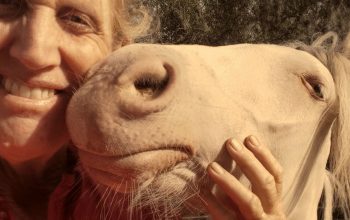By Evon Montgomery
 When approaching any new horse, whether in a training situation, clinic, or lesson, I’m always thinking with the end in mind. What does that end look like? A calm, quiet horse that I can do anything with: showing, trail riding, obstacles, clinics. My end goal is always a calm, quiet, responsive horse.
When approaching any new horse, whether in a training situation, clinic, or lesson, I’m always thinking with the end in mind. What does that end look like? A calm, quiet horse that I can do anything with: showing, trail riding, obstacles, clinics. My end goal is always a calm, quiet, responsive horse.
That’s why the first and last few minutes of a clinic or lesson with me – though they won’t look like much to an outsider – are extremely important and carefully thought out.
And all that those minutes involve is walking around the ring.
Well, there’s more to it than that, of course… and it often sounds much easier than it is! Back in the day we called it Warm up and Cool Down. It seems somehow in this fast and furious world we live in, people have forgotten how to be just – calm.
Horses learn by repetition. The first and last exercises that you do with your horse, whether in a lesson or clinic or trail ride or competition, are what your horse remembers. They’re the things that your horse is thinking about in the pasture when you walk towards him with a halter and lead rope.
Any negative experiences that your horse may have in the first and final moments of a ride can contribute to all sorts of negative behaviors: crankiness being groomed, girthiness, unwillingness to accept a bridle, not wanting to be caught, not standing still in the cross ties – if you dare cross tie, teeth grinding, pawing, ulcers, and the list goes on. While you always have to rule out medical or pain related problems for these issues, sometimes a horse balks before a ride simply because he’s remembering the last ride… and he’s not enjoying the memory. He’s dreading what’s going to happen when he goes into the ring.
Some horses aren’t as bright and won’t remember or won’t care. But the majority of others and the smart ones remember and anticipate previous rides with you. So, you want to give your horse reasons to look forward to your work together, and an easy way to do this is to make the first and last minutes of a ride something your horse predicts and looks forward to.
If the first thing you do on any ride is let your horse stretch and relax, your horse will be more ready and willing to work when you ask for it. Start your ride off slowly and pleasantly, and your horse will associate your rides with relaxation and enjoyment. The more you do the following exercise, the quicker your horse will relax on every ride.
What your warm up should look like:
After tacking your horse up, mount your horse when his legs are square and his head and neck are facing forward. Cranking your horse’s head around to mount puts him at risk for back injuries. If your horse doesn’t stand still for mounting, ask a friend for assistance holding him straight and still, or face a wall or fence to discourage him from twisting around when you mount.
 Once you’ve mounted, sit still and wait until your horse takes a deep breath, letting you know that he’s calm and ready to go. The theory behind this approach is teambuilding – by mounting, you’ve shown the horse that you’re ready but waiting for him, and when he takes a deep breath, he’s letting you know that he’s relaxed and ready for your next instruction.
Once you’ve mounted, sit still and wait until your horse takes a deep breath, letting you know that he’s calm and ready to go. The theory behind this approach is teambuilding – by mounting, you’ve shown the horse that you’re ready but waiting for him, and when he takes a deep breath, he’s letting you know that he’s relaxed and ready for your next instruction.
When you get the go-ahead from your horse, ask him to walk one direction on a loose rein. Do no more than walk until your horse again gives you a breath, and when he does so, gently steer in a large loop to change direction. Same thing this second way – walk on a loose rein until you get a deep breath from your horse.
Only then – when your horse has had a chance to lower his head and stretch and relax – should you gather your reins and start to work.
Repeat this exercise at the end of a ride. Hopefully, cooling down your horse is already part of your riding routine, but next time you do so, intentionally give your horse his head and pay attention for that deep relaxed breath both directions before you dismount.
When you first intentionally start and end your ride with this seemingly-simple exercise, it may take a while for your horse to walk quietly on a loose rein. But eventually, he’ll begin to realize that before and after every workout he gets to stretch and relax, and he’ll do so in just a few moments.
But it seems so easy?
Try this the next time you ride, and you may realize that it’s harder than you think.
Horses need to LEARN to be calm!
For many riders, the hardest thing for them to do is let their horses walk around with a loose rein and relax. So many riders want to immediately take up on the reins and begin steering and circling and trotting before the horse can even take a breath.
A few moments at the beginning and end of a ride where the horse can relax, stretch, and enjoy his connection with you will provide positive associations for your horse that he’ll remember the next time you get him out of the field.
Troubleshooting
The majority of the horses I see can’t relax. So the first thing that I do is sit still on their backs until they take a long breath. If a horse isn’t standing still, I wonder one of three things:
1) What has a human done to them?
2) Is the saddle fitting incorrectly?
3) What pain could this horse be in?
 Usually, a horse’s unwillingness to stand still is not because of pain– he’s just used to a person getting on and asking him immediately for forward motion. As long as I’m confident there isn’t a pain issue, I simply ask for a halt until a horse stands still and takes a breath. Sometimes a horse will realize that he’s being given time to stand and relax, and he’ll do so quickly. Often, though, this request confuses a horse, and if he’s getting more wound up being asked for a halt, I may let him walk forward in one direction on a loose rein if possible.
Usually, a horse’s unwillingness to stand still is not because of pain– he’s just used to a person getting on and asking him immediately for forward motion. As long as I’m confident there isn’t a pain issue, I simply ask for a halt until a horse stands still and takes a breath. Sometimes a horse will realize that he’s being given time to stand and relax, and he’ll do so quickly. Often, though, this request confuses a horse, and if he’s getting more wound up being asked for a halt, I may let him walk forward in one direction on a loose rein if possible.
If a horse starts jigging and can’t handle a loose rein, the first troubleshooting step is to turn on a slight angle towards the fence and loosen the reins a bit. Often, this barrier of a fence in the horse’s periphery will encourage the horse to calm and settle. Even if you only get a few calmer steps, turn towards the fence again and relax your reins. Repeat these steps as long as the horse is positively responding and settling down.
If the horse refuses to settle, even when angled toward the fence, turn him perpendicular to the fence and ask for a stop. If you get the stop, let the horse stand until he takes a deep breath. This may take multiple attempts! Repeatedly walk and stop towards the fence until he settles down.
If the horse doesn’t stop, the four-square pattern (the first exercise in Horses 1-2-3) is an exercise that will require the horse to slow his speed through a series of turns. I call it “Four Square Focus” because the horse has to pay attention – do this exercise until your horse learns that all you’re asking for is a simple walk.
If your horse is maintaining a walk on a loose rein but the walk is faster than you’d prefer, try to relax, yourself. Remember that a horse often feels the fears of his rider. A few simple half-halts may provide a speed check. Remember, quick changes in direction wind a horse up.
This may seem like an overly-simple concept, but a horse needs to be able to walk on a loose rein. You don’t always want to have to babysit your horse or have a constant hold of his mouth. You don’t always want to have to tell your horse exactly where to go. People have forgotten that a horse needs to be able to walk alone!
Be patient. If a whole lesson is spent just walking, in the grand scheme of things it’s a lesson well spent! Remember, we’re riding with the end in mind – and what most of us want as an end result is a calm, quiet horse!
Remember:
Life is an Adventure, Saddle up and Ride!




